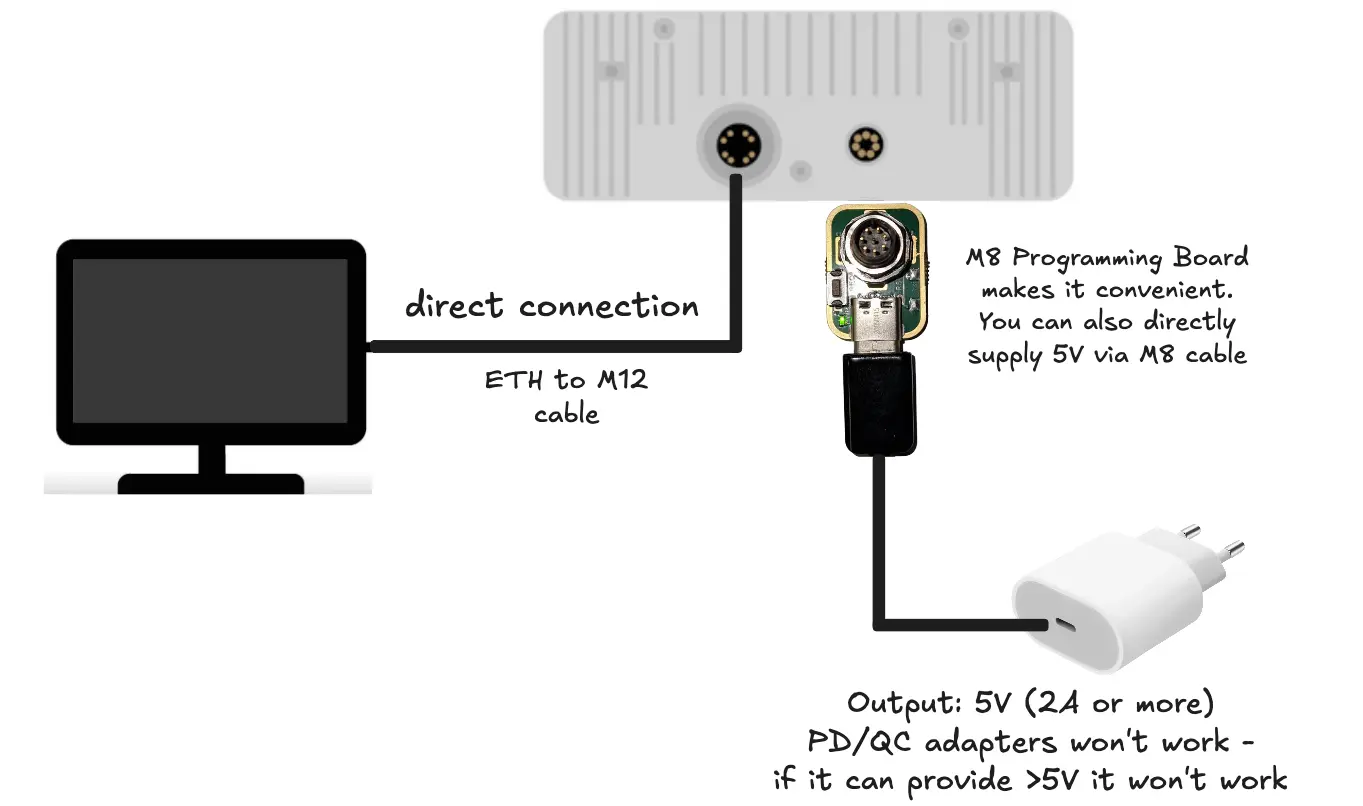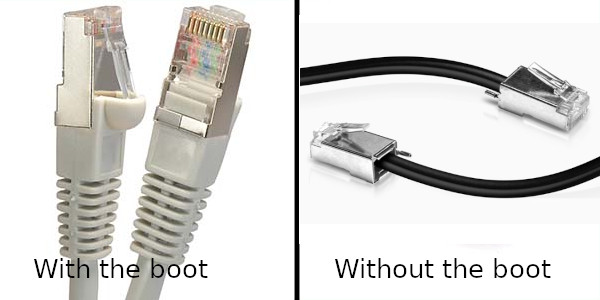Powering OAK PoE devices
PoE allows a single Cat5e (or higher) Ethernet cable to be used to both power a device and give it connectivity at up to 1,000 Mbps (1 Gbps) full-duplex at up to 100 meters (328 feet).In this tutorial, we will go through the suggested hardware to use with Luxonis PoE devices.The recommended way to use PoE devices (such as Luxonis' OAK PoE models) is with a PoE Ethernet Switch. Alternatively, if you already have a non-PoE switch that you have installed, you can use a PoE injector in conjunction with this switch. But using a PoE Ethernet Switch is advised, as these give you better control, the installation is cleaner, and insights (like power use) and control (like remote device power-down) are typically possible with a PoE Switch.Our OAK PoE cameras support both PoE Mode A and PoE Mode B (more information here).General specifications
- PoE Standard: 802.3af
- Max data transfer rate: 1 Gbps (1000BASE-T)
- Device power consumption: average ~4W, max 6.25W
PoE Switch or Injector
The advised way to use DepthAI OAK PoE models is with a PoE switch. We have a penchant for UniFi switches*, so we recommend these below, but any 802.3af (or higher, such as 802.3at, 802.3bt, etc.) can power and work with OAK PoE models.PoE Switches range in all sorts of sizes, power capacities, and port numbers. OAK PoE devices work with the lowest power PoE standard: 802.3af. Any 802.3af PoE switch can deliver 12.95W per port, which is actually substantially higher than the max power that OAK PoE models require (which is under 6.25W). So OAK PoE devices work with all standards-compliant PoE switches, including:- 802.3af - 12.95W per port
- 802.3at - 25.5W per port
- 802.3bt/3 - 51W per port
- 802.3bt/4 - 71W per port
- USW-Lite-8-PoE (here). This switch has 8 GbE RJ45 ports, including 4 PoE+ ports.
- USW-Lite-16-PoE (here). This switch has 16 GbE RJ45 ports, including 8 PoE+ ports.
- USW-16-PoE (here). This switch has 16 GbE RJ45 ports, including 8 PoE+ ports, and 2 1G SFP ports.
- USW-24-PoE (here).This switch has 24 GbE RJ45 ports, including 16 PoE+ ports, and 2 1G SFP ports.
- USW-48-PoE (here). This switch has 48 GbE RJ45 ports, including 32 PoE+ ports, and 4 1G SFP ports.
Powering from M8 connector
It's also possible to power the camera via M8 connector and still use M12 connector for ETH communication, like on the schematics below. QC/PD power adapters (more expensive ones) have logic in there (over current protection) that will limit the current output to 0.5A (USB standard), which will cause the device to brownout (crash) during initialization, and depthai will throw an error like this:
QC/PD power adapters (more expensive ones) have logic in there (over current protection) that will limit the current output to 0.5A (USB standard), which will cause the device to brownout (crash) during initialization, and depthai will throw an error like this:Command Line
1Failed to find device after booting, error message: X_LINK_DEVICE_NOT_FOUNDMax 7.5W
Note that we have current protection of max 1.5A (so 7.5W) on M8 connector, which might cause unexpected crashes if you're using heavy-processing pipeline (NN, video encoder, stereo...), or use IR projector/LED. As current protection will cut off power peaks as well, your device could crash even if average consumption is 5.5W, as some peaks can be 2W.
Powering from a battery
It is recommended to use PoE injectors that meet at least the 802.3af standard. If you are powering your PoE device from a car or solar battery you are limited by its output voltage, which is 12V for standard automotive batteries. In that case you need to find a PoE injector which will input 12V and output the voltage specified by the 802.3af standard.The following PoE injectors were tested on a 12V input:- GPOE-48V-10W: Input voltage: 10-30V, output voltage: 48V. Works as expected.
- Solis energy PoE-24 HPI-1112: Input voltage: 12V / 24V DC. Works as expected.
- Tycon Power TPDIN-1256GD-BT: Input voltage: 11 ~ 60V. Works as expected.
- Tycon Power TP-DC-1248GDX2-HP: Input voltage: 10 ~ 15V. Only starts powering its own LED at 15V, so it is unreliable, even though the IEEE standard is 802.3af.
- PoE Power bank IDEA4TEC was also reported to work with our OAK cameras.
Passive PoE
While active PoE adheres to standardized power levels and communications (eg. 802.3af), passive PoE does not. This makes them cheaper and viable option if you know what you are doing, as it can easily lead to overvoltage and damage the device.Our cameras require 48V, but from our testing they power up even at 40V. Note that most of these passive PoE injectors are 10Mbps (some are 100Mbps), which is quite slow, but can be suitable for certain applications, like only streaming metadata (NN results), low-resolution encoded stream, or high-resolution image every few seconds. We have used this PoE injector ($2 from Aliexpress, 10Mbps) From the image you can see that the power LEDs are on, which means that the camera is getting power. We are supplying 48V and it's consuming about 0.1A, so about 5W, which is as expected. It's (slowly) streaming encoded video stream to the computer.
From the image you can see that the power LEDs are on, which means that the camera is getting power. We are supplying 48V and it's consuming about 0.1A, so about 5W, which is as expected. It's (slowly) streaming encoded video stream to the computer.Ethernet Cables and weather resistance
The OAK PoE models are designed to allow outdoor use, including being weather resistant. As part of this weather resistance, there is a cablegland that provides the sealing around the Ethernet cable. These glands are designed to be used with "professional" installations, meaning that they are designed to be used with cable that is crimped to length for the installation and thus has no "boot". Cables with boots often will not fit in these water-sealing glands (since they are designed for these professional installations, which are "no-boot" installations). So, if you are installing outdoors, it is recommended to either use a no-boot pre-made cable, or us the "professional" technique of making the cable to length, or find a cable with a small boot that fits in the gland (some do). It is also worth noting that if installing outside, it is necessary to use a shielded Ethernet cable, otherwise wind/rain/hail/etc. will build up a static charge on the data wires in the cable and eventually destroy the PoE switch, the OAK PoE device, or both.For the custom-length cable route, you can use TOUGHCable PRO cable together with TOUGHCable connectors. Our team has used this combination extensively in the past for outdoor installations. (A crimping tool, such as this one is necessary to crimp the connectors to the cable.)
Cables with boots often will not fit in these water-sealing glands (since they are designed for these professional installations, which are "no-boot" installations). So, if you are installing outdoors, it is recommended to either use a no-boot pre-made cable, or us the "professional" technique of making the cable to length, or find a cable with a small boot that fits in the gland (some do). It is also worth noting that if installing outside, it is necessary to use a shielded Ethernet cable, otherwise wind/rain/hail/etc. will build up a static charge on the data wires in the cable and eventually destroy the PoE switch, the OAK PoE device, or both.For the custom-length cable route, you can use TOUGHCable PRO cable together with TOUGHCable connectors. Our team has used this combination extensively in the past for outdoor installations. (A crimping tool, such as this one is necessary to crimp the connectors to the cable.)We recommend using Cat5e ethernet cable, as the newer ones are bigger and might not fit properly in the IP67 gland.
Powering from USB
If you don't have a PoE injector or PoE switch nearby, and would like to use your OAK PoE camera, you have two options:- Connect the camera via USB-C so it works like the OAK-D (USB-C for power and communication). You need to change the DIP switch to 0x16 (as on the image here).
- Power the camera via USB-C while still communicating with it through ethernet as in the image below. You need to set static IP on your computer.
 Powering OAK-D-POE via USB-C connectorIf you go with the second option, you will need to set your computer's static IP. By default, the camera will have a static IP
Powering OAK-D-POE via USB-C connectorIf you go with the second option, you will need to set your computer's static IP. By default, the camera will have a static IP 169.254.1.222. So you would need to set your Ethernet adapter to static IP eg. 169.254.1.10 and netmask 255.255.0.0 in order for the OAK PoE camera to be in the same LAN and to be searchable by the DepthAI library.